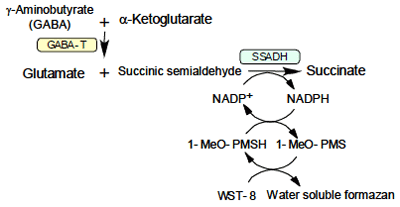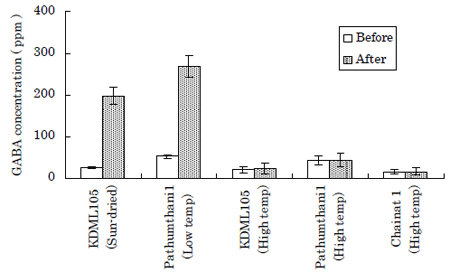Simple and rapid quantification method for gamma(γ)-aminobutyric acid in foods
Description
Gamma (γ)-aminobutyric acid (GABA) is one of the non-protein amino acids which are widely present in nature. Since the physiological functionality of GABA such as its hypotensive effects and stabilizing effect towards mental stresses or illnesses are well recognized in Japan, various foods with GABA addition or enhancement are being produced and their physiological functionality is emphasized. The quantification of GABA is conventionally performed with chromatographic method, High Performance Liquid Chromatography (HPLC), or amino acid analyzer. These methods require high initial investment for equipment, and due to their nature, it is necessary to analyze the samples sequentially, not simultaneously. These constraints prompted us to develop a new simple and rapid method which is based on enzymatic and colorimetric scheme.
The new method involves the conjugated action of two specific enzymes, GABA aminotransferase and succinate semialdehyde dehydrogenase. This conjugated action resulted in high specificity and sensitivity against GABA present in the sample. Using this method GABA could be quantified with the following procedure. The two enzymes, GABA aminotransferase and succinate semialdehyde dehydrogenase from Pseudomonas fluorescens, a-ketoglutarate and b-nicotinamide adenine dinucleotide phosphate (NADP+) were placed in a 96-well microplate. Diluted GABA samples were dispensed into each well, and then were warmed at 30°C for 15 min. The reaction was halted by the addition of acid, and the absorbance at 470 nm of the resulting water-soluble formazan was measured after color development with an electron carrier, 1-methoxyphenazinemethosulfate (1-MeO-PMSH) and tetrazolium salt, WST-8. (Fig. 1.) The method showed a linearity in the results for up to a GABA concentration of 50 ppm, and was not affected by the presence of other amino acids such as glutamate, serine, glycine or histidine. Furthermore, the results obtained correlated with those from the HPLC method in milled, brown and germinated rice samples. These results demonstrated the applicability of this new method to the measurement of GABA in the food matrix, which usually consists of various compounds. Additionally, the GABA content can be estimated even without a microplate reader, that is, by just comparing with the GABA standard.
The GABA concentration in brown rice is enhanced by inherent enzymatic activities during germination. However, the germination ratio is decreased when the rice is treated or dried under high temperature. Since rice harvested in Southeast Asia are sometimes dried under high temperature to avoid further deterioration by inherent enzymatic activities, this method was applied to elucidate the effect of such thermal treatment on GABA formation in brown rice. As shown in Fig. 2, the enhancement of GABA was observed only in sun-dried or low temperature-dried brown rice. High temperature-treated samples did not exhibit any enhancement.
The efficiency, speed and the dispensability of expensive instruments in this method make it an attractive alternative to conventional methods for GABA quantification in foods. Most especially, it can be used not only in laboratories but also in food factories to give assurance of the GABA content of their products.
Figure, table
-
Fig. 1. Principle of GABA quantification.
The conversion of GABA to formazan was carried out through the conjugated action of GABA aminotransferase (GABA-T) and succinate semialdehyde dehydrogenase (SSADH), with the latter converting NADP+ to NADPH. The resulting NADPH was formed with the reduction of tetrazolium salt (red) to water soluble formazan (yellow) coupled with an electron carrier, 1-MeO-PMSH. Therefore, GABA was converted stoichiometrically with the formation of formazan. -
Fig. 2. Effect of thermal treatment on GABA formation among Thai rice varieties.
The formation of GABA was observed only in sun-dried or low temperature- dried rice samples. Even with the same varieties, high temperature drying inactivated GABA formation activity during germination. -
-
- Affiliation
-
Japan International Research Center for Agricultural Sciences Post-harvest Science and Technology Division
- Classification
-
Technical A
- Term of research
-
FY2007(FY2006~2011)
- Responsible researcher
-
YOSHIHASHI Tadashi ( Post-harvest Science and Technology Division )
VARANYANOND Warunee ( Institute of Food Research and Product Development, Kasetsart University, Thailand )
TUNGTRAKUL Patcharee ( Institute of Food Research and Product Development, Kasetsart University, Thailand )
Surojanametakul Vipa ( Institute of Food Research and Product Development, Kasetsart University, Thailand )
- ほか
- Publication, etc.
-
特許出願 特願2008-106486
- Japanese PDF
-
2007_seikajouhou_A4_ja_Part16.pdf405.56 KB


